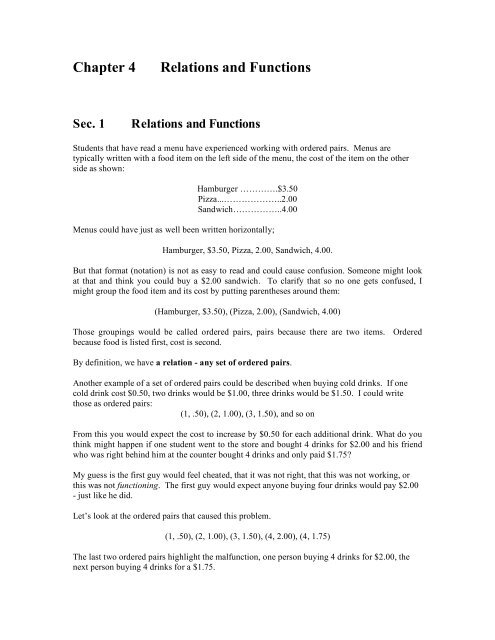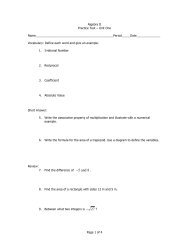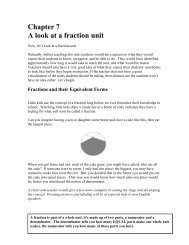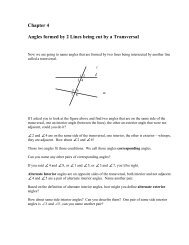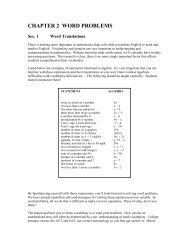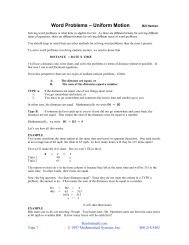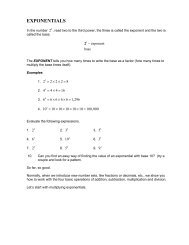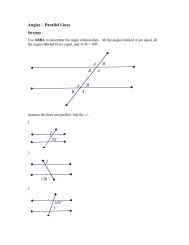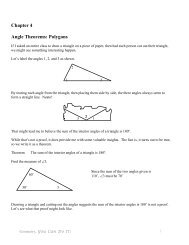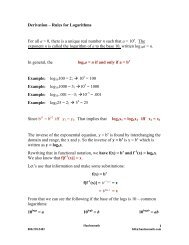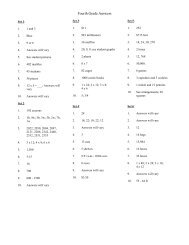Chapter 4 Relations and Functions - Hanlon Math
Chapter 4 Relations and Functions - Hanlon Math
Chapter 4 Relations and Functions - Hanlon Math
Create successful ePaper yourself
Turn your PDF publications into a flip-book with our unique Google optimized e-Paper software.
<strong>Chapter</strong> 4<br />
<strong>Relations</strong> <strong>and</strong> <strong>Functions</strong><br />
Sec. 1<br />
<strong>Relations</strong> <strong>and</strong> <strong>Functions</strong><br />
Students that have read a menu have experienced working with ordered pairs. Menus are<br />
typically written with a food item on the left side of the menu, the cost of the item on the other<br />
side as shown:<br />
Hamburger ………….$3.50<br />
Pizza...………………..2.00<br />
S<strong>and</strong>wich……………..4.00<br />
Menus could have just as well been written horizontally;<br />
Hamburger, $3.50, Pizza, 2.00, S<strong>and</strong>wich, 4.00.<br />
But that format (notation) is not as easy to read <strong>and</strong> could cause confusion. Someone might look<br />
at that <strong>and</strong> think you could buy a $2.00 s<strong>and</strong>wich. To clarify that so no one gets confused, I<br />
might group the food item <strong>and</strong> its cost by putting parentheses around them:<br />
(Hamburger, $3.50), (Pizza, 2.00), (S<strong>and</strong>wich, 4.00)<br />
Those groupings would be called ordered pairs, pairs because there are two items. Ordered<br />
because food is listed first, cost is second.<br />
By definition, we have a relation - any set of ordered pairs.<br />
Another example of a set of ordered pairs could be described when buying cold drinks. If one<br />
cold drink cost $0.50, two drinks would be $1.00, three drinks would be $1.50. I could write<br />
those as ordered pairs:<br />
(1, .50), (2, 1.00), (3, 1.50), <strong>and</strong> so on<br />
From this you would expect the cost to increase by $0.50 for each additional drink. What do you<br />
think might happen if one student went to the store <strong>and</strong> bought 4 drinks for $2.00 <strong>and</strong> his friend<br />
who was right behind him at the counter bought 4 drinks <strong>and</strong> only paid $1.75?<br />
My guess is the first guy would feel cheated, that it was not right, that this was not working, or<br />
this was not functioning. The first guy would expect anyone buying four drinks would pay $2.00<br />
- just like he did.<br />
Let’s look at the ordered pairs that caused this problem.<br />
(1, .50), (2, 1.00), (3, 1.50), (4, 2.00), (4, 1.75)<br />
The last two ordered pairs highlight the malfunction, one person buying 4 drinks for $2.00, the<br />
next person buying 4 drinks for a $1.75.
For this to be fair or functioning correctly, we would expect that anyone buying four drinks<br />
would be charged $2.00. Or more generally, we would expect every person who bought the same<br />
number of drinks to be charged the same price. When that occurs, we’d think this is functioning<br />
correctly. So let’s define a function.<br />
A function is a special relation in which no two different ordered pairs have the same first<br />
element. Since the last set of ordered pairs have the same first elements, those ordered pairs<br />
would not be classified as a function.<br />
If I asked students how much would 10 cold drinks cost, many might realize the cost would be<br />
$5.00. If I asked them how they got that answer, eventually, with prodding, someone might tell<br />
me they multiplied the number of cold drinks by $0.50. That shortcut can be described by a rule<br />
Cost = $0.50 x number of cold drinks<br />
c = .50n<br />
or the way you see written it in your math boob<br />
y = .50x or y = ½ x<br />
That rule generates more ordered pairs. So if I wanted to know the price of 20 cold drinks, I<br />
would substitute 20 for x. The result would be $10.00. Written as an ordered pair, I would have<br />
(20,10)<br />
Let’s look at another rule.<br />
EXAMPLE y = 3x + 2<br />
If we plug 4 in, we get 14 out, represented by the ordered pair (4, 14)<br />
If we plug 0 in, we get 2 out, represented by (0, 2)<br />
There is an infinite number of numbers I can plug in.<br />
A RELATION is any set of ordered pairs. The set of all first members of the ordered pairs<br />
is called the DOMAIN of the relation. The second numbers are called the RANGE of the relation.<br />
Sometimes we put restrictions on the numbers we plug into a rule, the domain. Those restrictions may<br />
be placed on the relation so it fits real world situations.<br />
For example, using our cold drink problem. If each drink costs $0.50, it would not make sense to find<br />
the cost of –2 drinks. You can’t buy negative two drinks, so we would put a restriction on the domain.<br />
The only numbers we could plug in are positive whole numbers; 0, 1, 2, 3, …<br />
The restriction on the domain also effects the range. If you can only use positive whole numbers for the<br />
domain, what values are possible for the range?<br />
We defined a FUNCTION as a special relation in which no two ordered pairs have the same first<br />
member.
What that means is that for every member of the domain there is one <strong>and</strong> only one member of the range.<br />
That means if I give you a rule, like y = 2x –3, when I plug in x = 4, I get 5 out. Represented by the<br />
ordered pair (4, 5). Now if I plug in 4 again, I have to get 5 out. That makes sense, it’s expected so just<br />
like the rule for buying cold drinks, this is working, this is functioning as expected, it’s a function.<br />
Now, you are thinking, big deal, isn’t that what we would expect?<br />
Looking at another rule might give us a clue, x² + y² = 25.<br />
Solving that for that y, we get y² = 25 – x²<br />
y =<br />
±<br />
25 ! x<br />
2<br />
Now if we plug in a number like 3, we get two answers, (3, 4) <strong>and</strong> (3, –4). You can see there is not one<br />
<strong>and</strong> only one member in the range for each member in the domain. Therefore this rule describes a<br />
relation that is not a function.<br />
We can look at the graphs of a relations, nothing more than a bunch (set) of ordered pair,s (points) <strong>and</strong><br />
determine if it’s a function.<br />
To determine if a graph describes a function, you use what we call the Vertical Line Test. That is, you<br />
try to draw a vertical line through the graph so it interests the graph in more than one point. If you can<br />
do that, then those two ordered pairs have the same first element, but a different second element.<br />
Therefore the graph would not describe a function.<br />
If there does not exist any vertical line which crosses the graph of the relation in more than one<br />
place, then the relation is s function. That is called the VERTICAL LINE TEST.<br />
What we try to do is draw a vertical line so it intersects the graph in more than one place. If we can’t<br />
then we have a graph of a function.<br />
Try these-<br />
a. Y b. Y c. Y<br />
X X X<br />
Why does this work? Well if we think about it for a few minutes we can see if there is more than one<br />
intersection, then that particular X has two different Y’s associated with it.<br />
Label the following as relations or functions.<br />
Y Y Y<br />
d, e. f.<br />
X
Only a. <strong>and</strong> e. are functions.<br />
We use functions almost every day in our lives, because we are just living, sometimes we don’t think of<br />
it as mathematics.<br />
Let’s look at a case in point. Let’s say you have a cell phone, the phone company charges you $10.00<br />
per month plus $0.05 per minute.<br />
Without a lot of math, you know if you don’t use the cell phone that month, you will be charged a flat<br />
rate of $10.00. If you speak for one minute, the charge will be $10.05, 2 minutes will be $10.10,<br />
3 minutes $10.15. If you spoke for one hour, you would be charged $13.00.<br />
I could describe that mathematically<br />
cost = $10.00 + $0.05minute<br />
c = 10 + .05m or c = .05m + 10<br />
or the way you see it written in math class<br />
y = .05x + 10<br />
Where y represents the cost <strong>and</strong> x represents the minutes spoken on the phone.<br />
Using fractions, that equation might also look like y = 1/20 x + 10<br />
Since those rules generate ordered pairs, all I need to do is plug in numbers to find the cost of using my<br />
phone for any number of minutes.<br />
Using the rule y = .05x + 10, I might ask how much it would cost to use the phone if I spoke for ten<br />
minutes.<br />
Someone else might ask how much it might be if they used the phone 20 minutes.<br />
Still more people could ask the cost of operating the phone for any number of minutes.<br />
As you can see, to ask these questions a full sentence has to be written, then we plug the desired number<br />
of minutes into our rule; y= .05x + 10<br />
Rather than wasting all that time <strong>and</strong> paper writing sentences, it might be nice to develop a shorth<strong>and</strong><br />
method (notation) to describe the same situation.<br />
Let’s go back to c = .05x + 10 to describe the cost of using the phone. Remember c represent the cost,<br />
x represents the number of minutes.<br />
c = .05x + 10
Rather than writing sentences to find the cost of speaking for 10 minutes, 20 minutes or any number of<br />
minutes , I could write these mathematically.<br />
c(x) = .05x + 10 read the value of c at x is .05 + 10<br />
c(10) = .05(10)x + 10 read the value of c at 10 is .05x + 10<br />
c(20) = .05((20) + 10 read the value of c at 20 is .05x +10<br />
c(30) = .05(30) + 10 read the value of c at 30 = .05x + 10<br />
<strong>and</strong> for x minutes it would be c(x) = .05x + 10, read the value of c at x = .05x + 10.<br />
Some like to say c of x = .05x + 10<br />
Sec. 2<br />
Combining <strong>Functions</strong><br />
<strong>Functions</strong> have some important properties that we often study later.<br />
If f <strong>and</strong> g are two functions with a common domain, then the sum of f <strong>and</strong> g, is defined to be:<br />
(f + g) (x) = f (x) + g(x)<br />
The difference of f <strong>and</strong> g is defined by: ( f – g) (x) = f (x) – g(x) <strong>and</strong> the quotient of f <strong>and</strong> g<br />
is defined by ( f g )(x) = ( f )( x )<br />
g( x)<br />
where g(x) cannot be zero.<br />
Let’s see what all that means.<br />
If f (x) = 3x <strong>and</strong> g(x) = x – 4,<br />
Now we will plug in a number for f <strong>and</strong> g, if x = 2, then<br />
f (2) = 6,<br />
g(2) = –2<br />
Adding those together, I get f(x) + g(x) = 6 + (–2)<br />
= 4<br />
If I were to add those functions f(x) + g(x) = (f + g)(x)<br />
(f + g)(x) = 3x + (x – 4)<br />
= 4x – 4
Now, if I plug 2 into that function, I get 4, just like I did before.<br />
(f + g) (x) = 4x – 4<br />
What we can see from this example is I can find the value of f(2) <strong>and</strong> the value of g(2) <strong>and</strong> add those<br />
two results together to find an answer or I could have combined f <strong>and</strong> g first into one rule, then found<br />
(f+g)(2). The answer is the same.<br />
You see that it works. <strong>Math</strong> = your life.<br />
While you may be wondering why someone might want to even bother with this, later it will help us in<br />
our graphing <strong>and</strong> save us some time computationally. By combining rules as we did with f <strong>and</strong> g, we<br />
can cut our work down considerable – particularly if we had a lot of computations to do.<br />
Sec. 3<br />
Composition of <strong>Functions</strong><br />
There are times when we may not want only to add or subtract functions as we just did, but compose a<br />
new function because the data we substitute in the first will be used to find the result of a second<br />
function.<br />
For instance, let’s say you are billed for your cell phone at a rate described by the following function<br />
(rule).<br />
C = 0.05x + 10<br />
In other words the cost of your cell phone is $10.00 per month plus five cents for each minute you<br />
speak.<br />
Let’s suppose you spoke for twenty minutes, you would be billed $11.00 for the month.<br />
Now, let’s say you are taxed at 8% on that amount <strong>and</strong> that is added to your bill. Well, that’s easy<br />
enough, I find the cost of the cell phone, take 8% of that number <strong>and</strong> add that sum to the bill. In our<br />
case, 8% of $11.00 is $0.88. So our bill is $11.88.<br />
Now, if I had one thous<strong>and</strong> customers <strong>and</strong> I wanted to to find their monthly tax bill. To accomplish<br />
that, I would have to find the monthly charge, then take 8%. While that’s not hard work, there’s two<br />
steps of computation that have to be completed.<br />
Wouldn’t it be nice if I could find a way of combining those functions into one rule – eliminating one of<br />
the computations?<br />
Let’s rewrite these two rules using mathematical notation. We’ll let f describe the cost of the cell phone<br />
as previously described:<br />
f(x) = 0.05x + 10<br />
And g describe the amount of tax to be paid based upon that bill.
g(x) = .08x<br />
As we have just done, to find the cost of the cell phone plus tax, I would have to plug into f the number<br />
of minutes I spoke, take that result <strong>and</strong> plug that into g to find the tax, <strong>and</strong> finally, add those two<br />
numbers together.<br />
As you can see, for each customer I have to perform three computations, find f, find g, then find the<br />
sum of f <strong>and</strong> g.<br />
Composition of functions allows me to combine functions when the second function depends upon the<br />
value of the first function. As we saw, g, the tax was dependent upon the monthly phone charge – f.<br />
Let’s do a quick review before going any further. We introduced functional notation as a shorth<strong>and</strong><br />
notation to determine values for various data points.<br />
So h(x) = 4x + 5 was read as “h at x is equal to 4x + 5”<br />
If I wanted to determine the value of h at 6, I would write h(6) = 4(6) + 5 or h(6) = 29.<br />
The point I want to drive home is – everywhere I saw an x, I substitute a 6.<br />
h(x) = 4x + 5<br />
h(6) = 4(6) + 5<br />
To compose a new function that will allow me to combine these two rules into one, I need to use this<br />
very same strategy of substitution.<br />
So, let’s go back to our phone problem, we have<br />
f(x) = 0.05x + 10<br />
g(x) = .08x<br />
If all I want to do is find the tax described by g, then I’m going to plug in f(x) everywhere I see an x in<br />
g.<br />
g(x) = .08x<br />
g{f(x)} = .08(f(x))<br />
g{f(x)} = .08 (.05x + 10)<br />
g{f(x)} = .004x + .80<br />
Given<br />
Substituting f(x) for x<br />
Substituting .05x + 10 for f(x)<br />
Simplifying (D-Property)<br />
This new function allows me to find the tax without first finding the monthly phone charge. So, to find<br />
the tax on using the phone 20 minutes, I merely plug 20 into my new formula.
g{f(20)} = .004(20) + .80<br />
= ,08 + .80<br />
= $0.88<br />
Now, if I wanted to use one rule to find the monthly cost plus tax, I would add the tax rule (.004x + .80)<br />
that we just found to the f, the monthly cost of the phone. Let’s call that rule T.<br />
T(x) = ,004x + .80 + f(x)<br />
T(x) = .004x + .80 + (.05x + 10)<br />
T(x) = .054x + 10.80<br />
What this allows us to do is use one rule to find the cost of using a cell phone plus tax. Otherwise,<br />
you’d have to find the monthly cost of the phone, find the tax based on that cost, then add those two<br />
amounts together. While that would not be much work if you only had to calculate a few bills, it would<br />
be a real pain in the neck if you had to calculate 1000 phone bills.<br />
Composing the new rule might take a couple of minutes up front, but it will save a lot of time in the<br />
long run. Let’s see how the new rule works for a monthly bill when you spoke for 20 minutes.<br />
T(x) = .054x + 10.80<br />
T(20) = .054(20) + 10.80<br />
T(20) = 1.08 + 10.80<br />
T(20) = 11.88<br />
Try the following compositions.<br />
1. If f(x) = 2x + 5 <strong>and</strong> g(x) = 3x + 1, find f{g(x)}<br />
2. From problem #1, find g{f(x)}<br />
3. If h(x) = x 2 <strong>and</strong> p(x) = x + 3, find h{p(x)}<br />
4. From problem #3, find p{h(x)}


